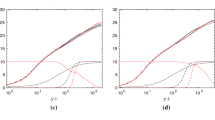Abstract
A transition zone model with formation of turbulent spots [1] is used to develop a method of calculating the heat flux in the conventional transition region. Allowance is made for the intermittent nature of the flow in the transition region, and subdivisions of the momentum-loss thickness in the laminar and turbulent boundary layers are used in the method of integral relations [2, 3] to evaluate heat flux in an individual turbulent spot; the result is an expression for the heat flux that is in good agreement with experimental data. An important aspect of the method is the choice of location of the actual origin of the turbulent boundary layer relative to the transition region. The actual origin is not fixed at any point, but turns out to be distributed over the whole transition zone.
Similar content being viewed by others
Abbreviations
- x, y:
-
coordinates along and normal to the body, respectively
- u, H, h:
-
gas velocity and the total and static enthalpies
- p,ρ,μ,σ :
-
pressure, density, viscosity, and Prandtl number, respectively
- r(x):
-
body surface shape
- θ :
-
momentum-loss thickness
- S:
-
Stanton number
- M:
-
Mach number of the undisturbed stream
- v=0 and 1:
-
two-dimensional and axisymmetrical flow, respectively
Literature cited
H. Schlichting, The Generation of Turbulence [Russian translation], Izd-vo Inostr. Lit., Moscow (1962).
T. Murphy and M. W. Rubesin, “A re-evaluation of heat transfer data obtained in flight tests of heatsink-shielded reentry vehicles,” J. Space and Rockets,3, No. 1, 53–60 (1966).
V. S. Avduevskii, “A method for computing the three-dimensional turbulent boundary layer in a compressible gas,” Izv. Akad. Nauk SSSR, OTN Mekh. i Mashinostr., No. 4 (1962).
E. R. Eckert, “Engineering methods for computing laminar and turbulent heat transfer and friction in high-speed gas flow over surfaces at constant pressure and temperature,” Vopr. Raketn. Tekh., No. 4 (1957).
G. B. Schubauer and P. S. Klebanoff, “Contributions to the mechanics of boundary layer transition,” NACA TN 3489 (1955).
J. R. Sterrett and P. F. Holloway, “Effects of controlled roughness on boundary layer transition at a Mach number of 6.0,” AIAA J.,1, No. 8 (1963).
B. E. Richards, “Transitional and turbulent boundary layers on a cold flat plate in hypersonic flow,” Aeronaut. Quart.,18, No. 3 (1967).
R. J. Sanator, J. P. de Carlo, and D. T. Corrilo, “Hypersonic boundary layer transition data for a cold-wall slender cone,” AIAA J.,3, No. 4, 758–760 (1965).
J. L. Potter and J. D. Whitfield, “Effects of slight nose bluntness and roughness on boundary layer transition in supersonic flows,” J. Fluid Mech.,12, pt 4, 501–535 (1962).
Author information
Authors and Affiliations
Additional information
Translated from Izvestiya Akademii Nauk SSSR, Mekhanika Zhidkosti i Gaza, No. 6, pp. 92–96, November–December, 1971.
The author thanks V. V. Lunev for his advice and comments.
Rights and permissions
About this article
Cite this article
Safiullin, R.A. Heat transfer in the boundary layer transition region. Fluid Dyn 6, 989–992 (1971). https://doi.org/10.1007/BF01019808
Received:
Issue Date:
DOI: https://doi.org/10.1007/BF01019808




